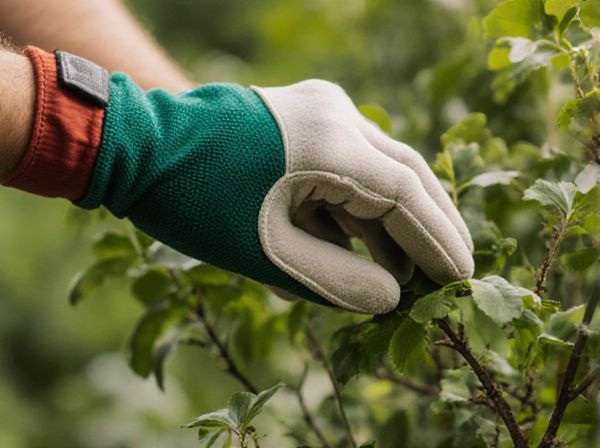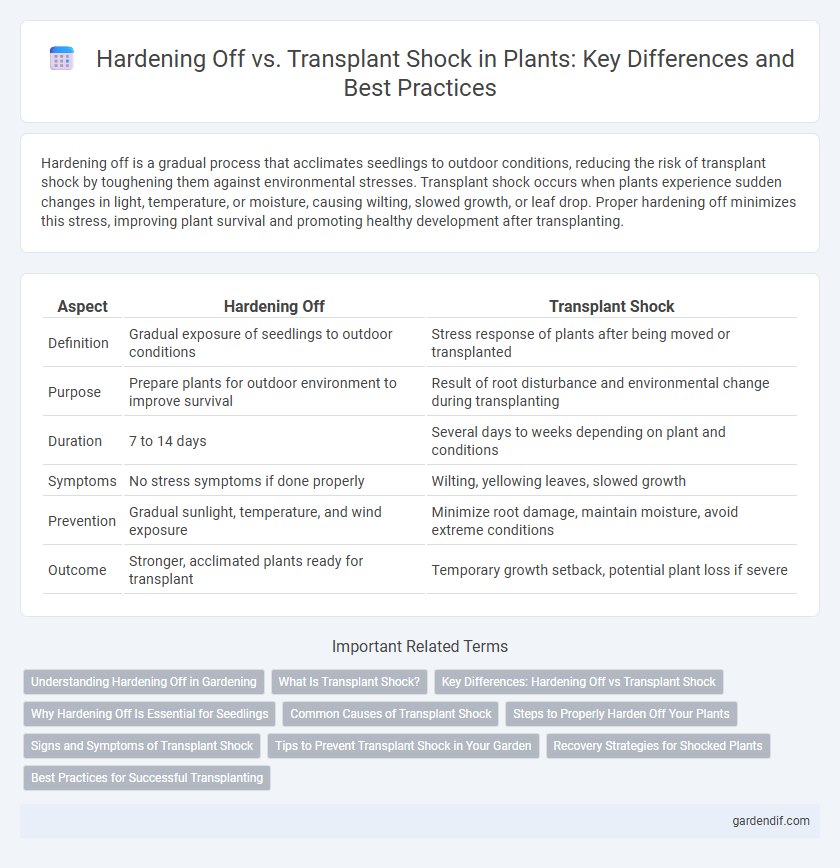
Hardening Off vs Transplant Shock Illustration
Hardening off is a gradual process that acclimates seedlings to outdoor conditions, reducing the risk of transplant shock by toughening them against environmental stresses. Transplant shock occurs when plants experience sudden changes in light, temperature, or moisture, causing wilting, slowed growth, or leaf drop. Proper hardening off minimizes this stress, improving plant survival and promoting healthy development after transplanting.
Table of Comparison
| Aspect | Hardening Off | Transplant Shock |
|---|---|---|
| Definition | Gradual exposure of seedlings to outdoor conditions | Stress response of plants after being moved or transplanted |
| Purpose | Prepare plants for outdoor environment to improve survival | Result of root disturbance and environmental change during transplanting |
| Duration | 7 to 14 days | Several days to weeks depending on plant and conditions |
| Symptoms | No stress symptoms if done properly | Wilting, yellowing leaves, slowed growth |
| Prevention | Gradual sunlight, temperature, and wind exposure | Minimize root damage, maintain moisture, avoid extreme conditions |
| Outcome | Stronger, acclimated plants ready for transplant | Temporary growth setback, potential plant loss if severe |
Understanding Hardening Off in Gardening
Hardening off is a critical gardening practice that gradually acclimates seedlings grown indoors to outdoor conditions, reducing their vulnerability to transplant shock. This process strengthens plant tissues by exposing them to natural sunlight, fluctuating temperatures, and wind over 7-10 days, fostering resilience. Without proper hardening off, seedlings often experience transplant shock, which can cause slowed growth, wilting, or even death due to sudden environmental changes.
What Is Transplant Shock?
Transplant shock is a physiological stress response experienced by plants when they are moved from one growing environment to another, often causing wilting, slowed growth, or leaf drop. This condition occurs due to root disturbance, changes in soil composition, moisture levels, or light exposure during transplanting. Managing transplant shock involves careful handling, sufficient watering, and a gradual acclimation process known as hardening off to enhance plant resilience.
Key Differences: Hardening Off vs Transplant Shock
Hardening off is the gradual process of acclimating young plants to outdoor conditions to enhance their resilience, while transplant shock refers to the stress and damage plants experience after being moved to a new environment. Hardening off involves controlled exposure to sunlight, wind, and temperature fluctuations over 7-14 days to strengthen plant tissues. Transplant shock symptoms include wilting, leaf drop, and slowed growth, often resulting from root disturbance, inadequate watering, or sudden environmental changes.
Why Hardening Off Is Essential for Seedlings
Hardening off is essential for seedlings because it gradually exposes them to outdoor conditions, increasing their resilience to temperature fluctuations, wind, and sunlight. This process reduces transplant shock by strengthening cell walls and improving water retention, ensuring healthier growth after planting. Without hardening off, seedlings are more susceptible to stress, wilting, and slower development once transplanted.
Common Causes of Transplant Shock
Transplant shock commonly results from root damage during digging, improper watering practices, and sudden changes in environmental conditions such as temperature, light, or humidity. Failure to harden off plants gradually exposes them to outdoor stresses, increasing vulnerability to shock. Nutrient deficiencies and soil compaction further exacerbate the stress, hindering root establishment and growth post-transplant.
Steps to Properly Harden Off Your Plants
Gradually expose plants to outdoor conditions over 7 to 10 days by increasing their time outside each day to strengthen stems and reduce transplant shock. Start by placing seedlings in a shaded, protected area, then slowly introduce them to direct sunlight and varying temperatures to acclimate them to the environment. Proper hardening off minimizes stress and improves survival rates when transplanting into gardens or containers.
Signs and Symptoms of Transplant Shock
Transplant shock in plants is characterized by wilting, yellowing leaves, and slowed growth, indicating stress from root disturbance during transplantation. Leaves may become scorched or brittle, and new growth often appears stunted or deformed. These symptoms contrast with hardening off, a controlled acclimation process that strengthens plants without causing such distress.
Tips to Prevent Transplant Shock in Your Garden
To prevent transplant shock in your garden, gradually harden off seedlings by exposing them to outdoor conditions for 7-10 days before transplanting. Ensure soil moisture is consistent, avoid disturbing roots during transfer, and plant at the same depth as in the original container. Using mulch and providing shade in the initial days post-transplant promotes recovery and reduces stress on plants.
Recovery Strategies for Shocked Plants
Recovery strategies for plants experiencing transplant shock involve gradual acclimatization to new environments and consistent care practices. Hardening off, which includes slowly exposing seedlings to outdoor conditions before transplanting, significantly reduces stress and improves survival rates by strengthening plant resilience. Post-transplant, maintaining optimal moisture levels, providing appropriate shading, and applying root stimulants or foliar feeds can accelerate recovery and promote robust growth.
Best Practices for Successful Transplanting
Gradual hardening off by exposing plants to outdoor conditions over 7-10 days enhances resilience and reduces transplant shock by acclimating seedlings to sunlight, wind, and temperature fluctuations. Watering deeply before and after transplanting helps maintain root hydration and supports recovery, while minimizing root disturbance ensures better establishment. Selecting the appropriate transplant site with optimal soil quality and spacing promotes healthy root growth and reduces stress from competition.
Hardening Off vs Transplant Shock Infographic

 gardendif.com
gardendif.com